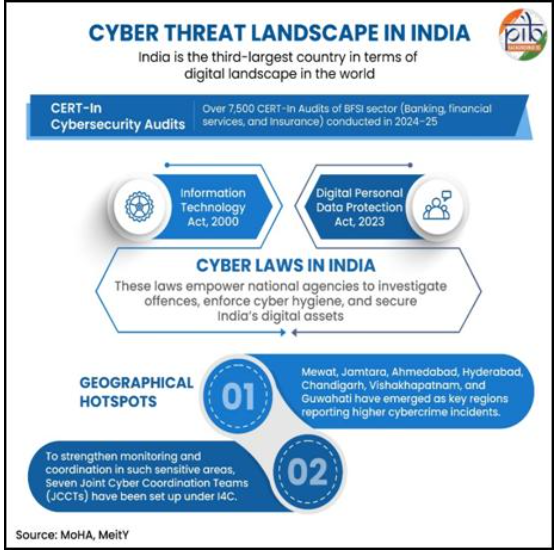“I dream of a Digital India where cyber security becomes an integral part of our national security” – Prime Minister Narendra Modi
Introduction
India’s cyberspace is busier than ever, carrying crores of transactions and interactions daily. With over 86% of households now connected to the internet, the expanding digital landscape has enabled citizens to access digital services at their fingertips. Simultaneously, it has widened the attack surface for cyber frauds, making cybersecurity a national priority.
The surge in cybersecurity incidents from 10.29 lakh in 2022 to 22.68 lakh in 2024 reflects the growing scale and complexity of digital threats. The financial toll is pronounced, with cyber frauds amounting to ₹36.45 lakh reported on the NCRP (National Cyber Crime Reporting Portal) as of 28 February 2025.
Key Takeaways
-
- Budgetary Allocation: Union Budget 2025 allocated ₹782 crore for cybersecurity projects.
- Enforcement Action: Over 9.42 lakh SIM cards and 2,63,348 IMEIs linked to fraudulent activities have been blocked.
- Incident Response: A dedicated cybercrime helpline number 1930 provides immediate assistance to victims of online financial frauds.
- Gaming Ban: The Promotion and Regulation of Online Gaming Bill, 2025 (passed 21st August 2025) imposes a complete ban on online money gaming.
- Skill Development: Over 1,05,796 police officers are registered on the CyTrain portal, with 82,704 certificates issued for cybercrime investigation.
Tracing Cyber Fraud Patterns
The evolving landscape shows that frauds are diverse, adapting to new technologies and user behavior, often linked to organized crime and fraud factories in Southeast Asia.
-
- Emerging AI Threats: Techniques like spoofing, deepfakes leveraging AI, and phishing are on the rise, amplifying the impact of scams.
- Targeting UPI: India’s preferred payment mode, UPI, is targeted using compromised mobile numbers. The Department of Telecommunications (DoT) launched the Financial Fraud Risk Indicator (FRI) to classify suspicious numbers as Medium, High, or Very High-risk.
- Illicit Ventures: Online betting apps have generated over ₹400 crores in criminal proceeds. This is now addressed by the Promotion and Regulation of Online Gaming Bill, 2025, which encourages e-sports and social online games while imposing a ban on money gaming.

India’s Cybersecurity Framework
The Government has implemented strong defense mechanisms underpinned by key legislation and specialized institutions.
A. Cyber Laws Securing Cyber Space
-
- Information Technology Act, 2000: The bedrock of India’s cyber law. It addresses offenses like identity theft, impersonation, and cheating by personation through computer resources.
- Digital Personal Data Protection Act, 2023: Requires that all personal data be handled lawfully and with user consent, placing strict obligations on data fiduciaries.
- IT Rules, 2021: Ensures accountability of social media intermediaries and mandates the removal of unlawful content.
B. Institutional Capacity and Resilience
-
- CERT-In (Indian Computer Emergency Response Team): The national agency for responding to cybersecurity incidents. It facilitates 109 cybersecurity mock drills, engaging 1,438 organizations to assess cyber readiness.
- NCIIPC (National Critical Information Infrastructure Protection Centre): The national nodal agency for the protection of critical information infrastructure in vital sectors (banking, telecom, power, and transportation).
- I4C (Indian Cybercrime Coordination Centre): Established under the Ministry of Home Affairs. It facilitates real-time information sharing and coordinated investigations, proactively blocking 3,962 Skype IDs and 83,668 WhatsApp accounts linked to cyber frauds.
Cybersecurity Initiatives
The following initiatives demonstrate the use of technology and coordination to mitigate and investigate frauds effectively:
-
- CFCFRMS (Citizen Financial Cyber Fraud Reporting and Management System):
- Enables financial institutions to save funds.
- Saved more than ₹5,489 crore in over 17.82 lakh complaints.
- Samanvaya Platform:
- Strengthens investigations using analytics-based interstate linkages of criminals and crimes.
- Its ‘Pratibimb’ module maps crime infrastructure, leading to 12,987 accused arrests.
- CCPWC Scheme (Cyber Crime Prevention Against Women and Children):
- Financial support of ₹132.93 crore established cyber forensic labs across 33 States/UTs.
- Trained over 24,600 personnel in investigation and digital forensics.
- National Cyber Crime Reporting Portal (NCRP) & 1930:
- Portal (www.cybercrime.gov.in) enables citizens to report crimes, with a focus on offenses targeting women and children.
- Helpline 1930 provides immediate assistance to victims of financial frauds.
- CFCFRMS (Citizen Financial Cyber Fraud Reporting and Management System):
Way forward
The government is investing in future resilience and public awareness:
-
- NM-ICPS (National Mission on Interdisciplinary Cyber-Physical Systems) plays a pivotal role in combating frauds by promoting advanced research and innovation in AI and cybersecurity tools for threat detection.
- Cyber Crisis Management Plan (CCMP) initiated for all government bodies to strengthen preparedness against cyber-attacks, with 205 workshops conducted to build capacity.
- Multi-platform outreach through radio, newspapers, metro announcements, and a Handbook for Adolescents and Students.
- The 9th India Mobile Congress (IMC 2025), themed “Innovate to Transform,” will feature a Cybersecurity Summit, focusing on 6G, AI, and IoT alongside 1.2 billion mobile subscribers and 970 million internet users.

